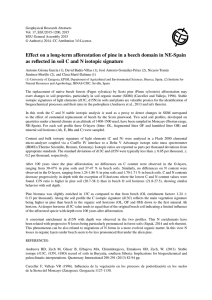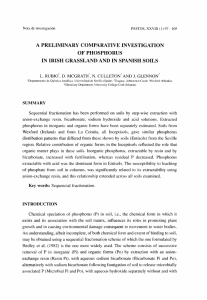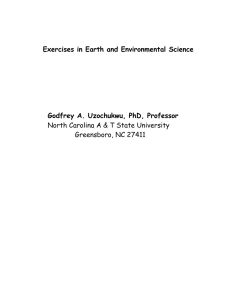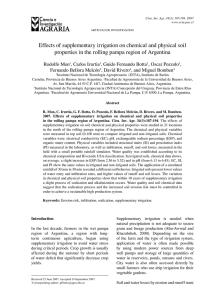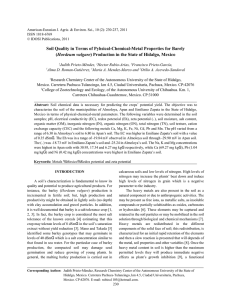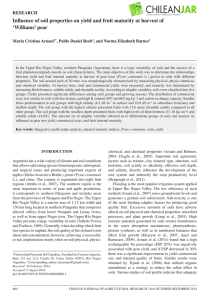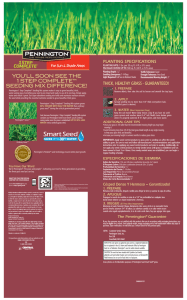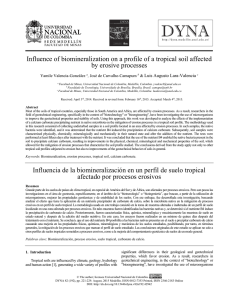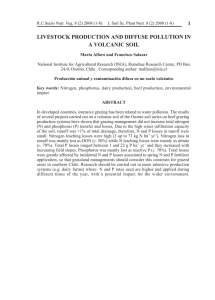Fundamentals of soils and revegetation
Anuncio
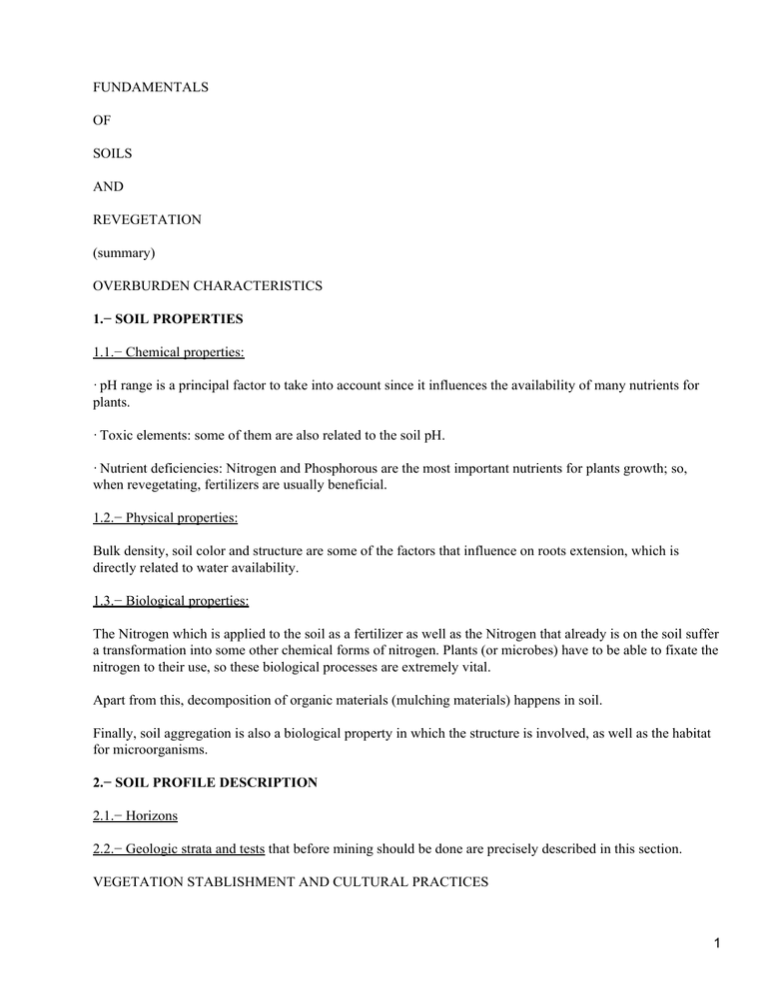
FUNDAMENTALS OF SOILS AND REVEGETATION (summary) OVERBURDEN CHARACTERISTICS 1.− SOIL PROPERTIES 1.1.− Chemical properties: · pH range is a principal factor to take into account since it influences the availability of many nutrients for plants. · Toxic elements: some of them are also related to the soil pH. · Nutrient deficiencies: Nitrogen and Phosphorous are the most important nutrients for plants growth; so, when revegetating, fertilizers are usually beneficial. 1.2.− Physical properties: Bulk density, soil color and structure are some of the factors that influence on roots extension, which is directly related to water availability. 1.3.− Biological properties: The Nitrogen which is applied to the soil as a fertilizer as well as the Nitrogen that already is on the soil suffer a transformation into some other chemical forms of nitrogen. Plants (or microbes) have to be able to fixate the nitrogen to their use, so these biological processes are extremely vital. Apart from this, decomposition of organic materials (mulching materials) happens in soil. Finally, soil aggregation is also a biological property in which the structure is involved, as well as the habitat for microorganisms. 2.− SOIL PROFILE DESCRIPTION 2.1.− Horizons 2.2.− Geologic strata and tests that before mining should be done are precisely described in this section. VEGETATION STABLISHMENT AND CULTURAL PRACTICES 1 1.− SOIL AMENDMENTS 1.1.− Fertility management: First of all, it depends whether we have an agricultural soil or a wildlife or forestry land. In the first case, fertility has to be really carefully managed before and after seeding, and during the next years in order to maintain the productivity. However, in reforestation and wildlife habitats a natural recovery of the ecosystem wants to be reached; therefore, no fertilizer maintenance should be done the years after the seeding. Nitrogen, Phosporous and Potasium (N, P, K) are the three main fertilizers. Nitrogen is more limiting for productivity than for germinating, so it could be avoided in the first place; nevertheless, it is usually applied in order to avoid future growing problems. But it is important to know when to apply N fertilizer to prevent a big leaching or a sudden big growth of plants which can be bad for them depending on the weather conditions (if it is too dry). P is also applied as a fertilizer, while K is not usually defficient on soils, so it is not so common to use it. Calcium (Ca) and Magnesium (Mg) are also important nutrients that affect plants growth; however, if an excessive amount of them is present on the soil they can be toxic. All this nutrients mentioned above should be applied when seedbed is being prepared, although it depends on when are going to seed (on the weather forecasting). 1.2.− Amelioration of acidity As it was mentioned before, soils pH is very important due to its influence to the nutrients availability as well as for the toxicity of some specific metals. Therefore, some liming materials are used and they are usually referred as calcium carbonate equivalents. There are two main agricultural liming materials: · dolomitic: contains magnesium carbonate. · calcic: it hardly ever contains magnesium carbonate. Agricultural lands pH is preferred to be in a pH 6.5 while wildlife and reforestation lands usually get better adaptation when the pH is around 5.5. These parameters tell us the liming rates that should be used, although it has to be taken into account whether the soil already has Mg or if it has not; because if we apply an excess of Mg it can be toxic for the plants. The depth has also have to be considered, since it reflects the depth that the roots would be able to develop into the soil. So, this shows that the amelioration of acidity has to be done before seeding. 1.3.− Amelioration of toxic elements: In some minesoils the presence of toxic elements can be a real problem to succeed on revegetation. Therefore, the first step that has to be done is the one described right before: liming until it reaches a pH between 5 and 7 range, where toxic elements are usually less toxic. Another option can be to plant specific species of plants which are tolerant to the specific toxic element that is present on the soil. 2 Some usually problematic types of soils which can be included in this section are saline soils and sodic soils. 1.4.− Organic materials: Organic materials benefit plant stablishment, as it was mentioned before, due to its capacity to prevent leaching and to retain water for plants growth. Moreover, organic matter provide with good chemical properties to the soil, reducing acidity for instance. The materials usually used for organic matter are agricultural, industrial, municipal, residential and forestry−related wastes. 1.5.− Microbiological material: Microorganisms are considered to be essential for the plants stablishment since most of the plants need symbiotic association with mycorrhizal fungi. Therefore, sometimes fungal spores are artificially inoculated when seeding or planting in order to guarantee a better microbiological activity. 2.− IRRIGATION Irrigation should only be considered as a temporary measure in dry regions, and once again, the water rate to be applied is directly related to all the factors described above (soil texture, organic matter, weather forecast...) as well as to the plantation density. 3.− WATER HARVESTING This technique focuses on collecting run off water to concentrate it in a zone for growing plants; this way, the production of biomass in dry zones can increase up to 2 to 3 times. 4.− SEEDING PRACTICES 4.1.− Site and seedbed preparation Seedbed preparation is usually required to guarantee the seeds germination. When talking about seedbed preparation, tillage is the most common practice in which we have to consider the following properties: · the moisture of the soil to avoid compacting the soil which is an important problem for trees growth. · the soils texture: we must ensure a good seed protection. Some of the most commonly used machines for primary tillage where the objective is to reduce compaction of the deepest soil layers are: − deep rippers: they can rip heavy and rocky minesoils to a depth of 3 feet, so it has to be used only in certain circumstances since it mixes te different horizons of the soil. − subsoilers: they can rip to a depth of 12−18 inches but they do not mix the horizons − chisel plows: this is a very successful machine for breaking compacted layers that are at 12 inches deep. Secondary tillage, which allows to prepare the surface layer for better growing conditions for the seeds, can be done with the following machinery: 3 − disking: it breaks up surface crusting, although it sometimes can lead to an excessive grading which may affect the growing conditions − roller harrow−packers: it pulverizes and firms the soil It has to be reminded that the intensity and timing of all the methods described above depend on the type of soil, climate and postmining land use. 4.2.− Methods of seeding: Drilling and broadcasting are the main used methods for seeding. In the first one, the seed is put inside a hole in the soil and covered afterwards with soil, while in broadcasting the seeds are scattered all around the surface with or without being later covered with soil. Drilling is usually more successful due to the fact that it is more precise; however, broadcasting is much cheaper and faster, although a bigger amount of seeds is needed. There is an specific type of broadcasting: hydroseeder. This special method of seeding is based in a high−pressure stream of water, so it can be used to seed steep slopes or any other particular site where drills or normal broadcasters cannot be used. Aircraft seeding has to be mentioned too since it can be used on large areas or inaccesible sites. 4.3.− Time of seeding Climate, seasonal growth patterns and moisture requirements are the main factors that influence on the time of seeding. 4.4.− Seed quality Seed quality is based on the pure crop seed as well as on the germination percentage. There are also more parameters, for instance, the percentage of weed seeds that can be harmful for the revegetation succession. 4.5.− Seeding rates The seeding rates are shown as PLS (pure live seed), which is determined multiplying the percent of pure crop seed by the germination and dividing by 100. Seeds are nowadays normally priced depending on the PLS. 4.6.− Inoculation of legume seed Some legumes should be planted on the revegetation site in order to ensure that rhizobia is present there, because, as it was mentioned before ( section 1.5.), a symbiotic relation is needed for nitrogen fixation in the ecosystem. 5.− PLANTING WOODY SPECIES Woody species stablishment is desired in forestry and wildlife habitat lands. In both cases, a natural succession is preferred in order to provide a heterogene nature wildlife habitat. These woody species can be planted in different ways: − nursery−grown seedlings: seeds are grown at least for one year in nursery beds and then, they are lifted 4 while they are still dormant. This kind of seedling is really cheap and easy to storage and transport; however survival rates are not always good. − container−grown planting stock: in this case, roots are better protected and plants can be available while nursery−grown seedlings are not. Therefore, the survival percentage is higher although this involves that it is more expensive. 5.1.− Planting methods After the seedlings have been prepared and adapted to transport them to the planting site, they can be planted by hand (planting bar or planting hoe) or by planting machines; but in any of both cases, it is important to keep roots moist and not to damage them. Direct seeding has not been very successful throughout these last years, so it is not considered to be a good method. 5.2.− Time of planting The best time for planting trees and shrubs is considered to be just before precipitation is expected (early spring rather than late fall). 5.3.− Tree−herbaceous competition First of all, planting patterns and spacing needs to be taken into account to avoid an excesive plantation density that leads it to a bigger competition between same plant species. But apart from that, a competition between trees or shrubs and another herbaceous is common and in this case, wooden species are usually affected and die; so herbaceous species must be controlled to avoid this happening. 6.− MULCHING In sites where environmental conditions are tough (for instance: low precipitation, high temperatures or salty soils), mulching is highly recomended. However, mulching is also good for any soil because it reduces erosion and helps revegetating. 6.1.− Considerations for mulch selection There is a wide variety of mulches depending basically on their weight and its content on organic matter. Considering organic mulches, it is very important the carbon−nitrogen ratio because if it has too much carbon, some nitrogen must be added to the soil to equilibrate this ratio. 6.2.− Mulching materials − Agricultural: usually straw of cereal grains are used rather than animal manures (this last one is preferred to be incorporated into the soil to prevent nitrogen loss). The drawback of these mulches is that some weed seed can be incorporated and they can compete with the desired seed. − Wood residues: these materials (hardwood bark) are specially good because of their high weight, so that wind doesn't mean a big problem for them, and moreover, no weed seeds are incorporated with them. − Wood fiber and cellulose: proccessed wood fiber is usually added with a hydromulch, mixed with water. 5 Once more, the advantage is the possibility to apply it on steep slopes or hardly reaching areas; but the disadvantage can be the lack of water. − Other mulching materials: some other materials are also used, and they are used as organic amendments; for instance: corn cobs, sawdust, composted municipal wastes and similar products. 6.3.− Soil stabilizers They are organic or inorganic chemical products that are applied with water to the soil in order to infiltrate into it (about 1 deep) and provide it with protection against erosion as well as to provide a better moisture. These stabilizers can be used in combination with the previously described mulches; however, they are not very commonly used due to their high price and difficulty to manage them. 6.4.− Application rates Mulch cover should be at least 75% of the surface to ensure a good soil protection, but the total amount of mulch used depends on the mulching material that is used. 6


